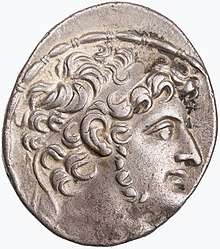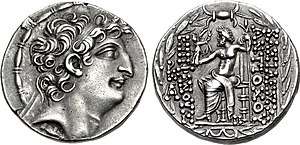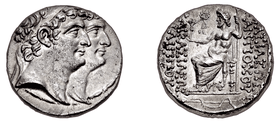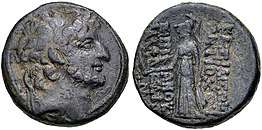Antiochus XI Epiphanes
| Antiochus XI Epiphanes | |
|---|---|
 Antiochus XI's portrait on the obverse of a tetradrachm | |
| King of Syria (Seleucid Empire) | |
| Reign | 94–93 BC |
| Predecessor | Seleucus VI, Demetrius III, Antiochus X |
| Successor | Demetrius III, Antiochus X, Philip I |
| Born | 125–111 BC |
| Died |
93 BC (aged 20–32) Antioch |
| Dynasty | Seleucid |
| Father | Antiochus VIII |
| Mother | Tryphaena |
Antiochus XI Epiphanes Philadelphus (Greek: Ἀντίοχος Ἐπιφανής Φιλάδελφος; unknown – 93 BC) was a Hellenistic Seleucid monarch who reigned as the King of Syria between 94 and 93 BC. He was the son of Antiochus VIII and his wife Tryphaena. Antiochus XI lived his early life in a period characterized by the constant civil war between his father and his uncle Antiochus IX. The conflict ended with the assassination of Antiochus VIII and a quick succession in Antioch, the capital of Syria, of Antiochus IX then Seleucus VI, the eldest son of Antiochus VIII.
Following the murder of Seleucus VI in 94 BC, Antiochus XI declared himself king together with his twin brother Philip I; his first act was to avenge his late brother by destroying Mopsuestia in Cilicia, the city responsible for the regicide of Seleucus VI. In 93 BC, Antioch, which was in the hands of Antiochus IX's son Antiochus X, who expelled Seleucus VI from the city, was taken by the twins. Antiochus XI appears to have been the senior king, minting coinage as a sole king and reigning alone in the capital, while Philip retreated to a base in northern Syria, but kept his royal title. The king's rule did not last long. In the autumn of the same year, Antiochus X regrouped and counter-attacked; Antiochus XI was defeated and drowned in the Orontes River as he tried to flee.
Biography
Name, family and early life

The name Antiochus is of Greek etymology and means "resolute in contention".[1] The capital of Syria, Antioch, was named after Antiochus, father of Seleucus I, the founder of the Seleucid dynasty;[2] this name became dynastic and many Seleucid kings bore it.[3][4] Antiochus VIII married in c. 125 BC to the Ptolemaic princess Tryphaena, who died in 111 BC.[5][6] The couple had many children including Seleucus VI, the eldest, and Antiochus XI and Philip I;[note 1][8] the mother of Philip I was mentioned explicitly as Tryphaena by Eusebius, who also mentioned that Antiochus XI and Philip I were twins (didymi).[11] Antiochus XI's date of birth is unknown, but by the time he came to power, he was, at least, in his twenties.[12]
In 113 BC, Antiochus IX declared himself king and started a civil war against his half brother Antiochus VIII. The conflict between the brothers would take a decade and a half;[13] it claimed the life of Tryphaena and ended with the assassination of Antiochus VIII at the hands of his minister in 96 BC.[14] In the aftermath of Antiochus VIII's death, Antiochus IX took the capital Antioch and married Antiochus VIII's second wife and widow, Cleopatra Selene.[14] The sons of Antiochus VIII responded; Demetrius III, a younger brother of Antiochus XI, took Damascus and ruled it,[7] while Seleucus VI killed Antiochus IX in 95 BC and took Antioch.[15] The new king was defeated by Antiochus IX's son Antiochus X, who took the capital.[16] Seleucus VI escaped to Mopsuestia where he was killed by rebels in 94 BC.[17]
Reign and end


In the aftermath of Seleucus VI's death, Antiochus XI and Philip I declared themselves kings in 94 BC; Alfred Bellinger suggested that their base was a coastal city north of Antioch,[18] while Arthur Houghton believed it was Beroea.[19][20] Both Antiochus XI and Philip I's portraits appeared on the obverses of jugate coins they struck;[8] Antiochus XI was portrayed in the front, showing that he was the senior monarch. According to Josephus, Antiochus XI became king before Philip I, but the numismatic evidence proves otherwise as the earliest coins show both brothers ruling jointly.[21] Drawing his legitimacy from his father, Antiochus XI appeared on his coinage with an exaggerated hawked nose, in the likeness of Antiochus VIII.[22] Hellenistic monarchs did not use regnal numbers but usually employed epithets to distinguish themselves from other kings with similar names, and the numbering of kings is mostly a modern practice.[23][3] On his coins, Antiochus XI appeared with the epithets Epiphanes (God Manifest) and Philadelphus (Brother Loving);[24][25] the latter was probably a sign of respect to Seleucus VI and Philip I.[26]

The earliest coins show Antiochus XI bearded, probably a sign of mourning and vengeance.[27] According to Eusebius, the brothers sacked Mopsuestia and destroyed it as a revenge for Seleucus VI.[note 2][11] At the beginning of 93 BC, the brothers advanced on Antioch and drove Antiochus X out of the city.[note 3][8] It seems that Philip ceded the capital to Antiochus XI;[20] the latter minted coinage as a sole king,[note 4][31] while Philip, who kept the royal title, retreated to the city which was his base during the preparations to avenge Seleucus VI and made it his capital.[32] According to the 6th-century monk and historian John Malalas, whose work is considered generally unreliable by scholars,[33] king Antiochus Philadelphus, i.e. Antiochus XI,[note 5] built a temple for Apollo and Artemis in Daphne, and set up two golden statues representing the gods, in addition to conferring the right of asylum to anyone who took refuge in the temple;[35] this statement can not be correct since the temple was attested during the time of Antiochus III (reigned 222–187 BC).[36] However, Glanville Downey, observing Malalas' writing style, suggested that by "building", Malalas meant renovating or restoring, which indicates that a predecessor of Antiochus XI might have desecrated the temple and melted the golden statues.[note 6][35]
Edward Theodore Newell assigned Antiochus XI a reign of few weeks in the capital, but estimating the annual die usage average rate of the king suggests a reign of several months in Antioch.[note 7][30] By autumn 93 BC, Antiochus X counter-attacked, defeating Antiochus XI,[8] who drowned in the Orontes River as he tried to flee.[38] Ancient accounts dealing with the last battle differ; according to Josephus, Antiochus XI fought alone. Eusebius have both Antiochus XI and Philip I in the battle.[note 8] In the view of Bellinger, the brothers' combined armies must have been deployed, but since only Antiochus XI perished, it is probable that Philip I stayed behind at his capital with Antiochus XI leading the army in the field.[21]
See also
Notes
- ↑ Five sons are known: Seleucus VI,[7] Antiochus XI and Philip I,[8] their younger brother Demetrius III,[9] and the youngest Antiochus XII.[10]
- ↑ This statement is doubtful because in 86 BC, Rome conferred inviolability upon the cult of Isis and Sarapis in Mopsuestia, which is proven by an inscription from the city, rendering Eusebius' account weak.[28]
- ↑ Ancient historians do not note Antiochus XI's reign in the capital, stating that he fought against Antiochus X and was defeated.[24] However, the 6th-century historian John Malalas, in his account over the Roman period in Antioch, mentions the reign of Antiochus XI.[29] In 1912, a coin struck in Antioch by Antiochus XI was published, providing the evidence for the success of the king in defeating the son of Antiochus IX.[24]
- ↑ Arthur Houghton attributed a jugate coin of Antiochus XI and Philip I to Antioch, but later retracted the attribution in favor of a Cilician mint.[30]
- ↑ This epithet was also used by king Antiochus XIII (reigned 82-65 BC).[34]
- ↑ Clement of Alexandria (lived 200 AD) reported that Antiochus IX melted a statue of Zeus, making him a candidate for the monarch who might have melted the statues of Apollo and Artemis.[35]
- ↑ The estimation is conducted using the Esty formula, which was developed by the mathematician Warren W. Esty; it is a mathematical formula that can calculate the relative number of obverse dies used to produce a certain coin series. The calculation can be used to measure the coinages production of a certain king and thus estimate the length of his reign.[37]
- ↑ Eusebius failed to note the reign of Antiochus XI in Antioch, stating that the final battle took place right after the destruction of Mopsuestia; a statement contradicted by archaeological evidence.[21]
References
Citations
- ↑ Ross 1968, p. 47.
- ↑ Downey 2015, p. 68.
- 1 2 Hallo 1996, p. 142.
- ↑ Taylor 2013, p. 163.
- ↑ Ogden 1999, pp. 153.
- ↑ Green 2008, p. 143.
- 1 2 Houghton & Müseler 1990, p. 61.
- 1 2 3 4 5 Houghton 1987, p. 79.
- ↑ Houghton 1987, p. 81.
- ↑ Lorber & Iossif 2009, p. 103.
- 1 2 Eusebius 1875, p. 261.
- ↑ Sievers 1986, p. 134.
- ↑ Kosmin 2014, p. 23.
- 1 2 Dumitru 2016, pp. 260, 261.
- ↑ Hoover 2007, p. 285.
- ↑ Dumitru 2016, p. 263.
- ↑ Houghton 1998, p. 66.
- ↑ Bellinger 1949, p. 93.
- ↑ Houghton 1987, p. 82.
- 1 2 Houghton 1998, p. 67.
- 1 2 3 Bellinger 1949, p. 74.
- ↑ Wright 2011, p. 46.
- ↑ McGing 2010, p. 247.
- 1 2 3 Newell 1917, p. 115.
- ↑ Dąbrowa 2011, p. 225.
- ↑ Coloru 2015, p. 177.
- ↑ Hoover, Houghton & Veselý 2008, p. 207.
- ↑ Rigsby 1996, p. 466.
- ↑ Downey 1938, p. 113.
- 1 2 Hoover 2007, p. 289.
- ↑ Bellinger 1949, p. 92.
- ↑ Bellinger 1949, pp. 75, 93.
- ↑ Scott 2017, p. 76.
- ↑ Dumitru 2016, p. 267.
- 1 2 3 Downey 2015, p. 131.
- ↑ Den Boeft et al. 1995, p. 229.
- ↑ Hoover 2007, pp. 282–284.
- ↑ Ehling 2008, p. 239.
Sources
- Bellinger, Alfred R. (1949). "The End of the Seleucids". Transactions of the Connecticut Academy of Arts and Sciences. Connecticut Academy of Arts and Sciences. 38. OCLC 4520682.
- Coloru, Omar (2015). "I Am Your Father! Dynasties and Dynastic Legitimacy on Pre-Islamic Coinage Between Iran and Northwest India". Electrum: Journal of Ancient History. Instytut Historii. Uniwersytet Jagielloński (Department of Ancient History at the Jagiellonian University). 22. ISSN 1897-3426.
- Dąbrowa, Edward (2011). "ΑΡΣΑΚΗΣ ΕΠΙΦΑΝΗΣ. Were the Arsacids Deities 'Revealed'?". Studi Ellenistici. Fabrizio Serra Editore. 24. ISBN 978-88-6227-351-0. ISSN 1828-5864.
- Den Boeft, Jan; Drijvers, Jan Willem; Den Hengst, Daniël; Teitler, Hans (1995). Philological and Historical Commentary on Ammianus Marcellinus XXII. Philological and Historical Commentary on Ammianus Marcellinus. 3. Brill. ISBN 978-90-69-80086-8.
- Downey, Glanville (1938). "Seleucid Chronology in Malalas". American Journal of Archaeology. Archaeological Institute of America. 42 (1). ISSN 0002-9114.
- Downey, Robert Emory Glanville (2015) [1961]. A History of Antioch in Syria from Seleucus to the Arab Conquest. Princeton University Pres. ISBN 978-1-400-87773-7.
- Dumitru, Adrian (2016). "Kleopatra Selene: A Look at the Moon and Her Bright Side". In Coşkun, Altay; McAuley, Alex. Seleukid Royal Women: Creation, Representation and Distortion of Hellenistic Queenship in the Seleukid Empire. Historia – Einzelschriften. 240. Franz Steiner Verlag. ISBN 978-3-515-11295-6. ISSN 0071-7665.
- Ehling, Kay (2008). Untersuchungen Zur Geschichte Der Späten Seleukiden (164-63 v. Chr.) Vom Tode Antiochos IV. Bis Zur Einrichtung Der Provinz Syria Unter Pompeius. Historia – Einzelschriften (in German). 196. Franz Steiner Verlag. ISBN 978-3-515-09035-3. ISSN 0071-7665.
- Eusebius (1875) [c. 325]. Schoene, Alfred, ed. Eusebii Chronicorum Libri Duo (in Latin). 1. Translated by Petermann, Julius Heinrich. Apud Weidmannos. OCLC 312568526.
- Green, Peter (2008) [2007]. The Hellenistic Age (Paperback ed.). Modern Library. ISBN 978-1-588-36706-8.
- Hallo, William W. (1996). Origins. The Ancient Near Eastern Background of Some Modern Western Institutions. Studies in the History and Culture of the Ancient Near East. 6. Brill. ISBN 978-90-04-10328-3. ISSN 0169-9024.
- Hoover, Oliver D. (2007). "A Revised Chronology for the Late Seleucids at Antioch (121/0-64 BC)". Historia: Zeitschrift für Alte Geschichte. Franz Steiner Verlag. 56 (3). ISSN 0018-2311.
- Hoover, Oliver D.; Houghton, Arthur; Veselý, Petr (2008). "The Silver Mint of Damascus under Demetrius III and Antiochus XII (97/6 BC-83/2 BC)". American Journal of Numismatics. second. American Numismatic Society. 20. ISBN 978-0-89722-305-8. ISSN 1053-8356.
- Houghton, Arthur (1987). "The Double Portrait Coins of Antiochus XI and Philip I: a Seleucid Mint at Beroea?". Schweizerische Numismatische Rundschau. Schweizerischen Numismatischen Gesellschaft. 66. ISSN 0035-4163.
- Houghton, Arthur; Müseler, Wilhelm (1990). "The Reigns of Antiochus VIII and Antiochus IX at Damascus". Schweizer Münzblätter. Schweizerische Zeitschrift für Numismatik. 40 (159). ISSN 0016-5565.
- Houghton, Arthur (1998). "The Struggle for the Seleucid Succession, 94-92 BC: a New Tetradrachm of Antiochus XI and Philip I of Antioch". Schweizerische Numismatische Rundschau. Schweizerischen Numismatischen Gesellschaft. 77. ISSN 0035-4163.
- Josephus (1833) [c. 94]. Burder, Samuel, ed. The Genuine Works of Flavius Josephus, the Jewish Historian. Translated by Whiston, William. Kimber & Sharpless. OCLC 970897884.
- Kosmin, Paul J. (2014). The Land of the Elephant Kings: Space, Territory, and Ideology in the Seleucid Empire. Harvard University Press. ISBN 978-0-674-72882-0.
- Lorber, Catharine C.; Iossif, Panagiotis (2009). "Seleucid Campaign Beards". L'Antiquité Classique. l’asbl L’Antiquité Classique. 78. ISSN 0770-2817.
- McGing, Brian C. (2010). Polybius' Histories. Oxford University Press. ISBN 978-0-199-71867-2.
- Newell, Edward Theodore (1917). "The Seleucid Mint of Antioch". American Journal of Numismatics. American Numismatic Society. 51. ISSN 2381-4594.
- Ogden, Daniel (1999). Polygamy, Prostitutes and Death: The Hellenistic Dynasties. Duckworth with the Classical Press of Wales. ISBN 978-0-715-62930-7.
- Rigsby, Kent J. (1996). Asylia: Territorial Inviolability in the Hellenistic World. Hellenistic Culture and Society. 22. University of California Press. ISBN 978-0-520-20098-2.
- Ross, Alan S. C. (1968). "Aldrediana XX: Notes on the Preterite-Present Verbs". English Philological Studies. W. Heffer & Sons, Ltd for the University of Birmingham. 11. ISSN 0308-0129.
- Scott, Roger (2017) [1989]. "Malalas and his Contemporaries". In Jeffreys, Elizabeth; Croke, Brian; Scott, Roger. Studies in John Malalas. Byzantina Australiensia. 6. Brill. pp. 67–85. ISBN 978-9-004-34462-4.
- Sievers, Joseph (1986). "Antiochus XI". In Yarshater, Ehsan. Encyclopaedia Iranica. 2. Routledge & Kegan Paul. ISBN 978-0-710-09110-9. ISSN 2330-4804.
- Taylor, Michael J. (2013). Antiochus the Great. Pen and Sword. ISBN 978-1-848-84463-6.
- Wright, Nicholas L. (2011). "The Iconography of Succession Under the Late Seleukids". In Wright, Nicholas L. Coins from Asia Minor and the East: Selections from the Colin E. Pitchfork Collection. The Numismatic Association of Australia. ISBN 978-0-646-55051-0.
External links
| Wikimedia Commons has media related to Antiochus XI Epiphanes. |
- Several coins of Antiochus XI exhibited in the blog of the numismatist Jayseth Guberman.
- The biography of Antiochus XI in the website of the numismatist Petr Veselý.
Antiochus XI Epiphanes Born: Unknown Died: 93 BC | ||
| Preceded by Seleucus VI Demetrius III Antiochus X |
King of Syria 94–93 BC with Demetrius III (94–93 BC) Antiochus X (94–93 BC) Philip I (94–93 BC) |
Succeeded by Demetrius III Antiochus X Philip I |